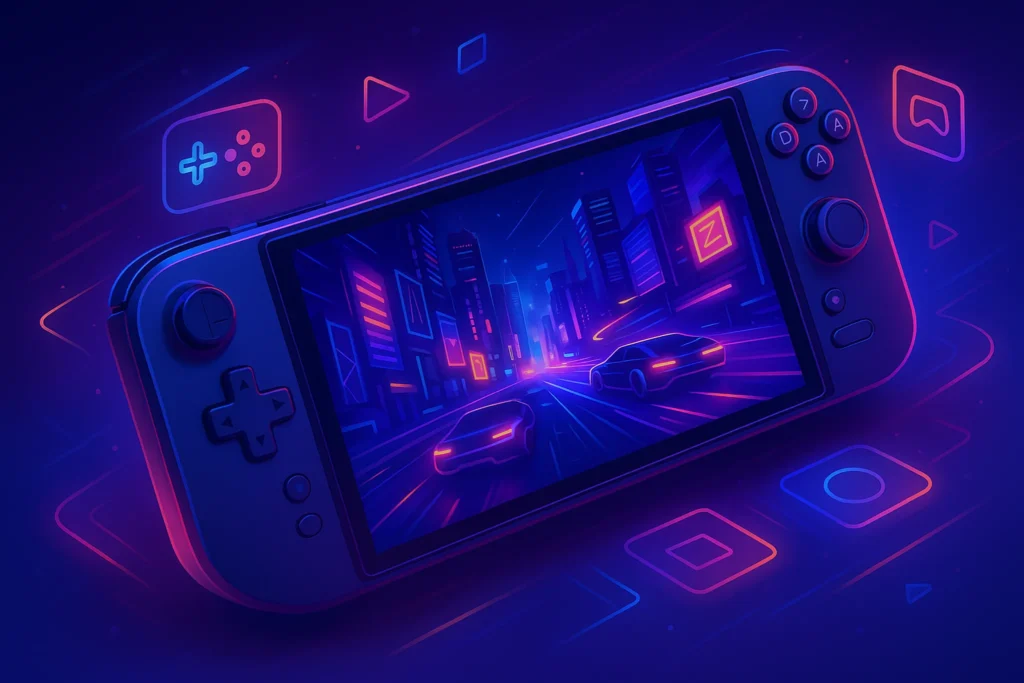🎯 Introduction: Why the OLED Upgrade Matters
When Valve launched the original Steam Deck, it redefined portable PC gaming. Suddenly, gamers had access to their full Steam library on a handheld device powerful enough to handle everything from indie favorites to AAA blockbusters. But like all first-generation hardware, the Steam Deck had its compromises—most notably in display quality and battery efficiency.
Enter the Steam Deck OLED. This isn’t just a minor refresh; it’s a meaningful upgrade designed to fix some of the most common complaints about the original model. With a new OLED display, better battery life, quieter fans, and slightly refined ergonomics, the OLED version promises to elevate the handheld experience for both casual players and hardcore enthusiasts.
But does it truly justify the jump if you already own the LCD version? Or is it finally the right time to invest if you’ve been holding off? Let’s break down every aspect of the Steam Deck OLED and see how it stacks up in 2025’s increasingly competitive handheld gaming market.
Many readers still wonder if the Steam Deck OLED is a smart choice for people who only play occasionally. If you’re not planning to dive into competitive sims or tweak every setting, the device still holds up perfectly well for casual sessions. In fact, our deeper breakdown in Is the Steam Deck Worth It for Casual Gamers? explores exactly how Valve’s handheld performs when gaming is more of a hobby than a lifestyle.
🖥️ Display: From LCD to OLED Excellence
The headline feature of this new model is, of course, the OLED screen. Valve has upgraded the 7-inch display to a vivid HDR OLED panel with higher brightness and deeper contrast. Blacks are finally black rather than the washed-out grays of the LCD, and colors look stunningly rich whether you’re exploring the vibrant worlds of Hades II or the gritty atmosphere of Cyberpunk 2077.
Another advantage is the higher refresh rate—jumping to 90Hz. While not essential for every game, the smoother motion adds noticeable fluidity in fast-paced titles. Paired with improved response times, the OLED panel makes competitive experiences, such as Counter-Strike 2, far more enjoyable on the go.
Gamers upgrading from the original will immediately notice that the screen quality feels premium, closer to a flagship smartphone than a mid-range tablet. The difference is even more pronounced when playing indie games with distinct art styles—pixel art and hand-drawn visuals simply shine.
🔋 Battery Life: More Efficient, Less Stress
One of the original Steam Deck’s biggest weaknesses was battery life. Running heavy titles could drain the handheld in under two hours, forcing players to stay near outlets. Valve’s OLED refresh tackles this with a larger battery and more power-efficient components.
In practice, you can expect anywhere between 25–40% more battery life depending on what you’re playing. For less demanding indie games, the Deck now comfortably hits 5–7 hours, and even graphically intense AAA titles see a significant improvement. This might not make it an all-day handheld, but it finally feels viable for train rides, flights, or lounging sessions away from chargers.
Combined with the OLED’s efficiency and new adaptive refresh rates, you’ll spend more time immersed in gameplay and less time worrying about whether the device will survive a session.
The OLED upgrade also unlocks new ways to enjoy community-driven titles. Steam has always been a hub for co-op creativity, and the handheld form factor makes playing with friends far more flexible. Whether it’s a weekend dungeon run or experimenting with quirky indie mechanics, you’ll find plenty of choices that fit the portable format. If you’re curious where to start, check out our curated picks of Best Co-Op Indie Games on Steam for 2025 to discover experiences that truly shine on the Steam Deck OLED.
🎮 Performance: Familiar but Optimized
The Steam Deck OLED doesn’t change the core CPU or GPU architecture; it runs the same AMD APU as before. However, Valve has optimized thermal performance and tuned the power delivery system, making the device slightly more efficient overall.
What this means for gamers is a more consistent experience. Games that previously fluctuated in performance now feel a bit smoother, especially with the higher refresh rate. The cooling system is also quieter, making the handheld more pleasant to use during long play sessions.
While it doesn’t outpace competitors like the ASUS ROG Ally in raw specs, the Steam Deck continues to hold its ground thanks to Valve’s deep integration with SteamOS and Proton compatibility. Simply put: most games just work without fiddling.
For players looking at alternatives, we’ve compared the Steam Deck vs ASUS ROG Ally to help you evaluate which handheld suits your gaming style best.
🛠️ Ergonomics and Build Quality
Valve has subtly refined the ergonomics with this release. The OLED model is slightly lighter, which reduces strain during extended handheld play. Buttons and thumbsticks feel just as responsive, but the improved weight distribution makes it easier to hold for long sessions.
Build quality remains solid—this still feels like a premium device rather than a fragile gadget. Valve also included Wi-Fi 6E support for faster downloads and smoother streaming, a welcome addition for gamers who often tap into cloud gaming services.
The carrying case included with the OLED models is also redesigned to be more practical, making travel setups easier for players who want to pack chargers, docks, or small accessories alongside the handheld.
Remember: the Steam Deck OLED isn’t just about specs—it’s about transforming where and how you play. Every upgrade adds up to a more seamless, enjoyable experience.
📊 Comparison: Steam Deck OLED vs Alternatives
| Device | Display | Battery Life | Performance | OS & Ecosystem | Price (2025) |
|---|---|---|---|---|---|
| Steam Deck OLED | 7″ OLED 90Hz | 5–7 hours | Optimized APU | SteamOS + Proton | $549–$649 |
| Steam Deck LCD | 7″ LCD 60Hz | 3–5 hours | Same APU | SteamOS + Proton | $399–$549 |
| ASUS ROG Ally | 7″ IPS 120Hz | 2–5 hours | Higher Raw Power | Windows 11 | $699–$799 |
| Lenovo Legion Go | 8.8″ IPS 144Hz | 3–6 hours | High-End GPU | Windows 11 | $699+ |
This comparison highlights why the OLED is more than a cosmetic upgrade. It hits the sweet spot for balance: excellent screen, good battery life, and smooth software integration—without the compatibility headaches that sometimes plague Windows-based handhelds.
🎨✅ Checklist: Must-Have Gear for Steam Deck Owners
-
A reliable USB-C dock for connecting to TV or monitors
-
A microSD card (1TB recommended) for expanding storage
-
A protective carrying case for travel
-
Bluetooth earbuds or a wired headset for immersive audio
-
An external controller for couch multiplayer
🧠 Nerd Pick
Looking to get your own Steam Deck OLED? You can purchase it directly from Valve’s official store, but many retailers also carry bundles with microSD cards or docks included. If you’re considering accessories, brands like Anker, SanDisk, and Logitech offer reliable add-ons that make the experience even smoother. Affiliate links can be placed naturally when recommending docks, controllers, or storage solutions.
⏳ Long-Term Value vs Alternatives
When considering a device like the Steam Deck OLED, one question inevitably arises: how long will this handheld remain relevant in the rapidly evolving world of portable gaming? The good news is that Valve has committed to supporting the platform with continuous software updates, Proton compatibility improvements, and community-driven enhancements. This means the OLED model isn’t just a prettier screen—it benefits from an ecosystem that’s constantly growing and refining itself.
By contrast, alternatives like the ASUS ROG Ally and Lenovo Legion Go are more powerful but run on Windows. That may sound like an advantage on paper, but in practice, these devices often struggle with optimization, battery drain, and fragmented updates. The Steam Deck OLED, even with slightly lower raw horsepower, consistently delivers smoother performance thanks to its purpose-built OS and close integration with Steam’s library.
From a value perspective, the OLED model also holds its own because of pricing. For under $650, you’re getting a handheld that can serve as a mini gaming PC, streaming machine, and even a productivity device when docked. Considering the cost of building a budget desktop setup—which we break down in How to Build a Budget Gaming Setup Under $800—the Steam Deck OLED provides a surprisingly strong all-in-one package for gamers unwilling to compromise portability.
🎨 Who Should Buy Which Handheld?
💡 Different devices suit different gamer profiles. Here’s a quick breakdown:
-
Steam Deck OLED → For the everyday gamer who values balance.
If you want strong performance, a gorgeous OLED display, and access to Steam’s vast library without worrying about constant tweaking, this is your best bet. It’s ideal for gamers who enjoy everything from indies to AAAs and want a hassle-free handheld that “just works.” -
ASUS ROG Ally → For the power-hungry Windows tinkerer.
The ROG Ally shines if you love to mod, experiment, and push hardware to its limits. Its Windows environment allows broader compatibility with apps, but you’ll sacrifice battery life and ease of use. This is for gamers who don’t mind troubleshooting in exchange for more raw power. -
Lenovo Legion Go → For hybrid gamers and big-screen lovers.
With its detachable controllers and massive display, the Legion Go leans into hybrid use cases. It works well docked, in tablet-style gaming, or with detachable inputs. It’s not as polished for handheld play as the Steam Deck OLED, but if you want versatility and sheer screen real estate, it’s compelling.
📌 Nerd Tip: If your main goal is pure gaming without headaches, stick with the Steam Deck OLED. If you want to experiment, ROG Ally or Legion Go may fit better—but know they’ll demand more tinkering.
🚀 The Future of Portable PC Gaming
The Steam Deck OLED also represents more than just a hardware revision—it’s a sign of where handheld gaming is headed. We’re witnessing a renaissance where gaming is no longer tethered to living room consoles or desk-bound PCs. The OLED model, with its improved visuals and efficiency, sets a new bar for competitors and cements Valve as a serious player in the space.
One of the most exciting implications is the way this handheld can bridge indie and AAA ecosystems. Smaller studios now design with handheld optimization in mind, while big publishers recognize the Deck’s growing audience. This balance of accessibility and depth has already made the Deck one of the best ways to explore upcoming titles—especially when looking at lists like the Most Anticipated Indie Games of 2025.
Looking ahead, it’s not hard to imagine Valve pushing further into modular upgrades, accessory ecosystems, or even a Steam Deck 2 with next-gen silicon. But for now, the OLED version feels like the “final form” of the original design—a product that is polished, practical, and finally living up to its potential.
For gamers who want a glimpse of the future of handheld play, this device delivers an experience that feels both modern and future-proof.
🧠 Nerd Verdict
The Steam Deck OLED is the handheld upgrade that gamers were hoping for. While it doesn’t reinvent the platform, it refines it in meaningful ways—better screen, stronger battery, and a smoother user experience. For first-time buyers, this is the model to get. For existing owners, the decision depends on how much you value display quality and endurance, but once you’ve played on OLED, it’s hard to go back.
❓ FAQ: Nerds Ask, We Answer
💬 Would You Bite?
Would you upgrade to the Steam Deck OLED for its new display and battery life, or stick with the original?
Drop your thoughts below—we’d love to hear your take. 👇



